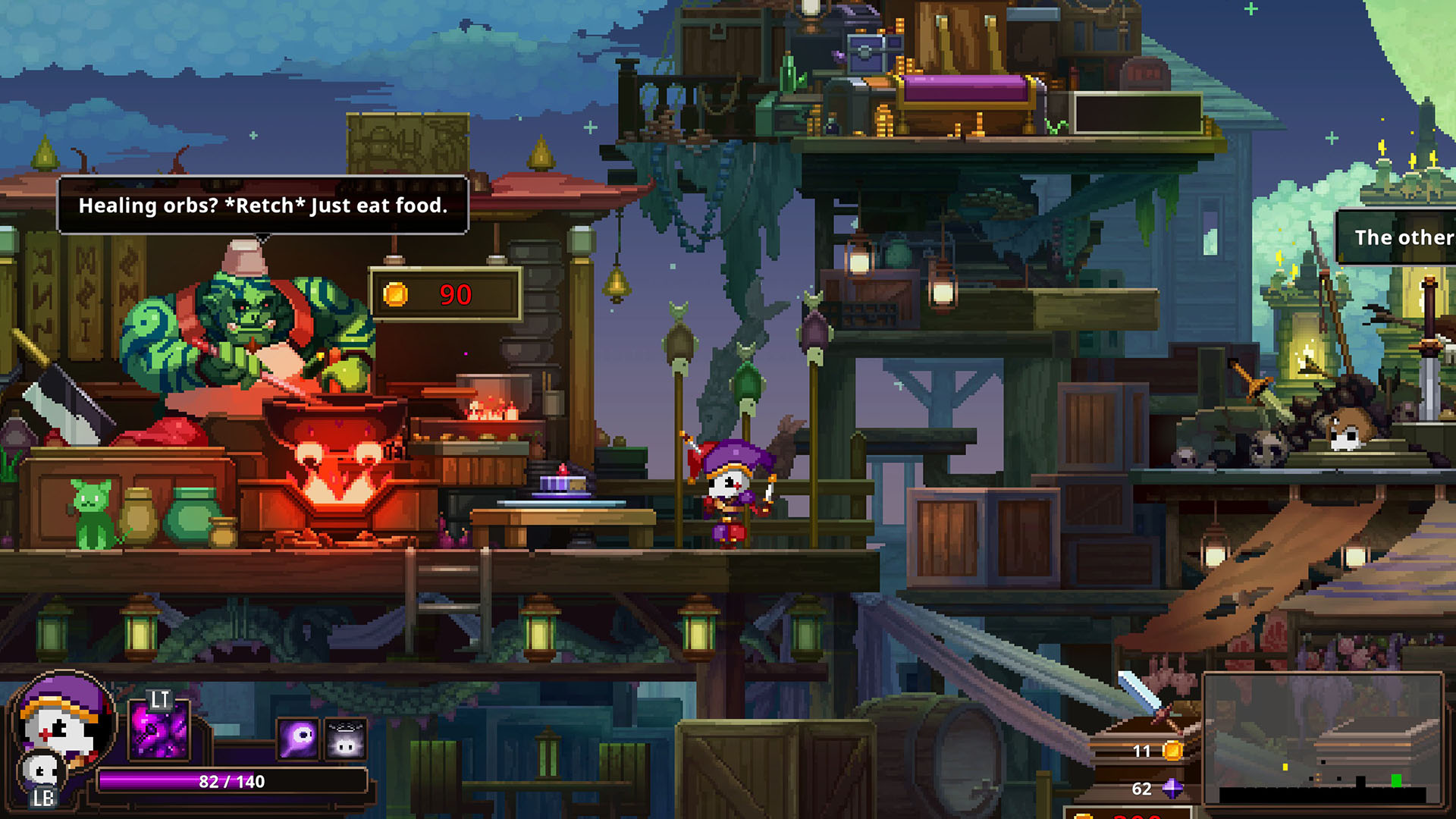
This sentiment began to seep into the roguelike nature of Skul in a negative way. I constantly came across the werewolf skull, the Groot-like Ent skull, and basic melee fighters. While I found most skulls to be satisfying to use, it can turn exhausting after encountering the same dozen or so skulls for the initial chunk of the game. It may sound overwhelming but players can easily see what a skull can do from their menu or by simply standing over the skull and reading its stats. Finally, when swapping between either skull, a unique ability will trigger but also prevent players from swapping back until the cooldown resets. Many skulls are equipped with passive abilities that trigger when their requirements are fulfilled. Equipped skulls can have up to three unique abilities that are set to a cooldown and are mainly used to deal burst damage or eliminate multiple targets at once. Regardless of what head he has, Skul is capable of double jumping, dashing on the ground or in mid-air, and attacking. Personally, I gravitated towards power skulls as they doled out more damage but players have the ability to equip two skulls at a time so striking a balance is not difficult to do. Skulls focus on power, speed, or a blend of the two.
Skul the hero slayer skulls skin#
But the beauty is not only skin deep as players will find out when experimenting with various builds. Visually, Skul‘s design impresses as each of these skulls looks and animates differently and usually has multiple forms when upgraded. Once I played as the Predator and several times I had a warrior skull that had a red slash across his face like Kratos. Players may come across a genie that triples in size after bursting out of a magic lamp or a Ghost Rider knock-off that uses a chain and can hop on a motorcycle to run over enemies.

The most common skulls are basic physical attackers that use swords, shields, and daggers to attack. Skulls range from simple in concept to weird or referential. Throughout every run whether at a shop or as a reward for clearing a room, new skulls can be equipped that grant new powers and a new moveset. In his starting form, Skul is a simple fighter that can whack heroes with a large bone club, throw his skull for magic damage, and teleport to where that skull lands. The meat of Skul: The Hero Slayer is the dozens of skulls that players can equip to alter and improve Skul’s base abilities. But did I care? Ultimately, I thought Skul had a cute but forgettable story that didn’t force itself down the player’s throat and resulted in a surprisingly lengthy finale. Of course Skul’s past is important and certainly there is more than meets the eye to the heroes and their fight against the demons. Other NPCs will offer some world building if you pester them enough but the repetitive, lengthy nature of gameplay almost guarantees you’re going to forget most of the finer points. Bits and pieces of plot unfold through cutscenes, after boss fights, and a handful of conversations between characters. From there, the story doesn’t really go anywhere and that’s perfectly okay. Players learn there was a truce between the demons and Carleon and that something or someone caused that truce to be broken.

Skul might not have skin and his friends might have two heads but these aren’t your typical monsters. Skul, a tiny skeleton, borrows a fellow skeleton’s head and fights his way through the steel plated forces only to be absolutely walloped by a human calling himself The First Hero. Skeleton and ogre warriors are defeated and the Witch has been captured.

The Demon Castle has been overrun by the knights of Carleon and the Demon King has been kidnapped. SouthPAW Games gently twists the narrative by passing the baton over to the perspective of the “bad guys” or, in the world of Harmonia, demons. But stories have never been their strong suits and Skul makes few strides in that arena. There’s something about these games that are so inherently simple yet complex enough to beg repeated plays. Despite this glaring hole (I’m waiting for a PlayStation release), Supergiant’s ability to weave a tale in a roguelike seems to be one of Hades‘ highlights. Irresistible scope of Hades be damned, I must confess to not having played one of 2020’s obvious champions. The game pushes a unique power-swapping mechanic that would make Kirby grin and it’s there that Skul becomes something more, despite striking many familiar cords that would make lesser games crumple. Like many roguelikes, Skul needs a deep pool of variety to incentivize players to keep pushing through familiar fights and repetitive content. After a few dozen runs through Skul: The Hero Slayer I was surprised that the game kept managing to dole out new items and powers for my minuscule skeleton to use in his fight against the forces of good.


 0 kommentar(er)
0 kommentar(er)
